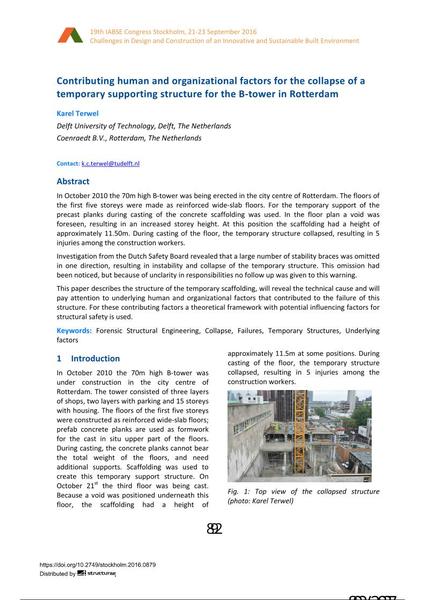Contributing human and organizational factors for the collapse of a temporary supporting structure for the B-tower in Rotterdam

|
|
|||||||||||
Détails bibliographiques
| Auteur(s): |
Karel Terwel
(Delft University of Technology, Delft, The Netherlands Coenraedt B.V., Rotterdam, The Netherlands)
|
||||
|---|---|---|---|---|---|
| Médium: | papier de conférence | ||||
| Langue(s): | anglais | ||||
| Conférence: | IABSE Congress: Challenges in Design and Construction of an Innovative and Sustainable Built Environment, Stockholm, Sweden, 21-23 September 2016 | ||||
| Publié dans: | IABSE Congress Stockholm, 2016 | ||||
|
|||||
| Page(s): | 892-898 | ||||
| Nombre total de pages (du PDF): | 7 | ||||
| Année: | 2016 | ||||
| DOI: | 10.2749/stockholm.2016.0879 | ||||
| Abstrait: |
In October 2010 the 70m high B-tower was being erected in the city centre of Rotterdam. The floors of the first five storeys were made as reinforced wide-slab floors. For the temporary support of the precast planks during casting of the concrete scaffolding was used. In the floor plan a void was foreseen, resulting in an increased storey height. At this position the scaffolding had a height of approximately 11.50m. During casting of the floor, the temporary structure collapsed, resulting in 5 injuries among the construction workers. Investigation from the Dutch Safety Board revealed that a large number of stability braces was omitted in one direction, resulting in instability and collapse of the temporary structure. This omission had been noticed, but because of unclarity in responsibilities no follow up was given to this warning. This paper describes the structure of the temporary scaffolding, will reveal the technical cause and will pay attention to underlying human and organizational factors that contributed to the failure of this structure. For these contributing factors a theoretical framework with potential influencing factors for structural safety is used. |
||||
